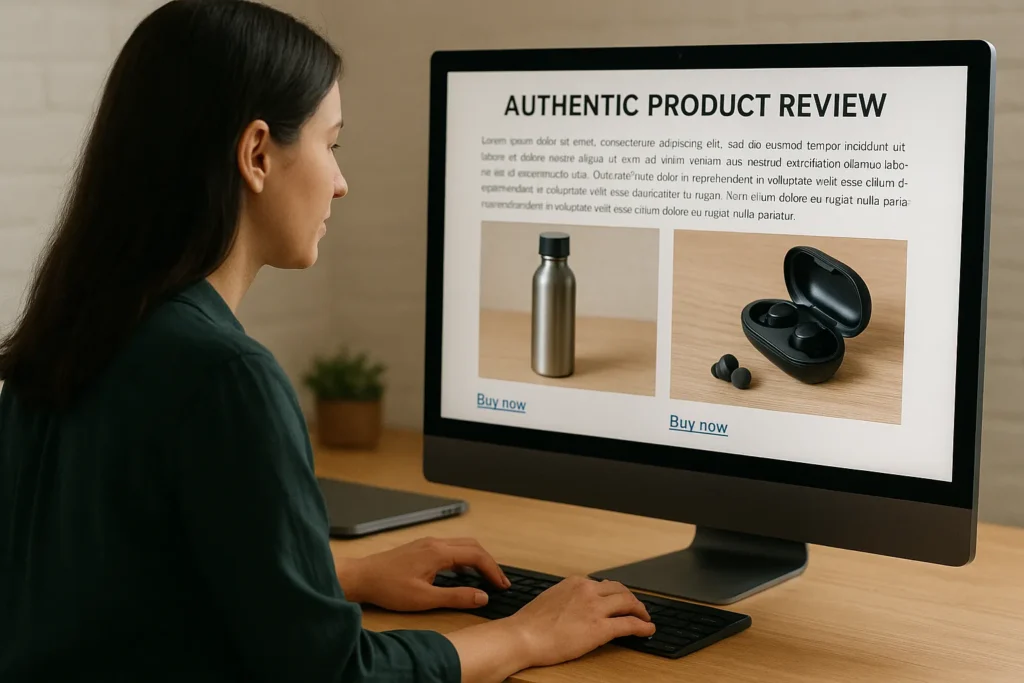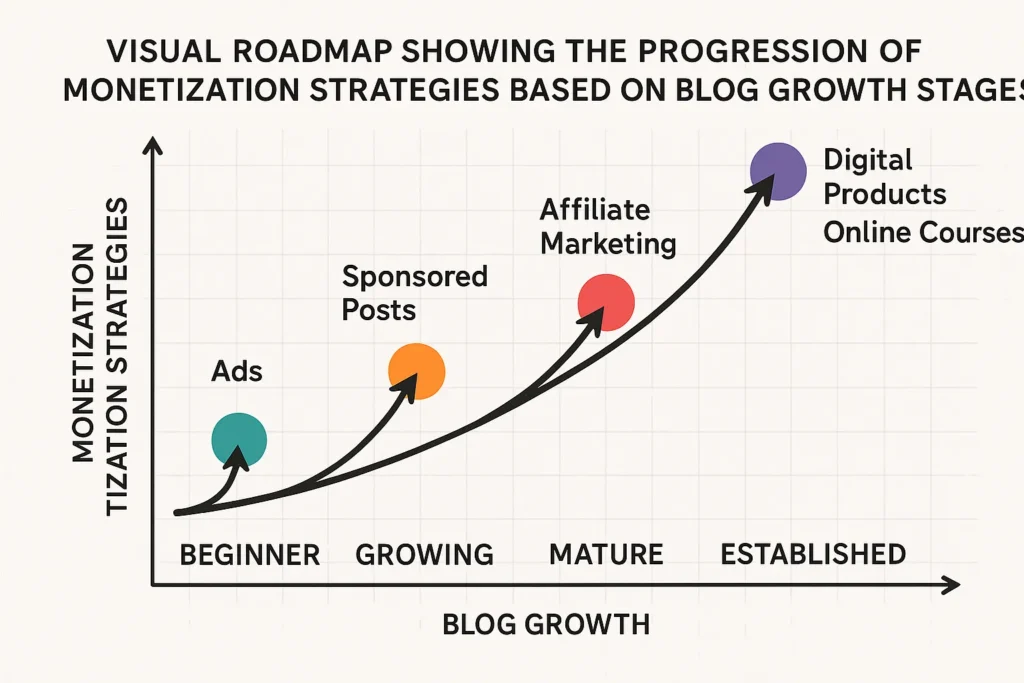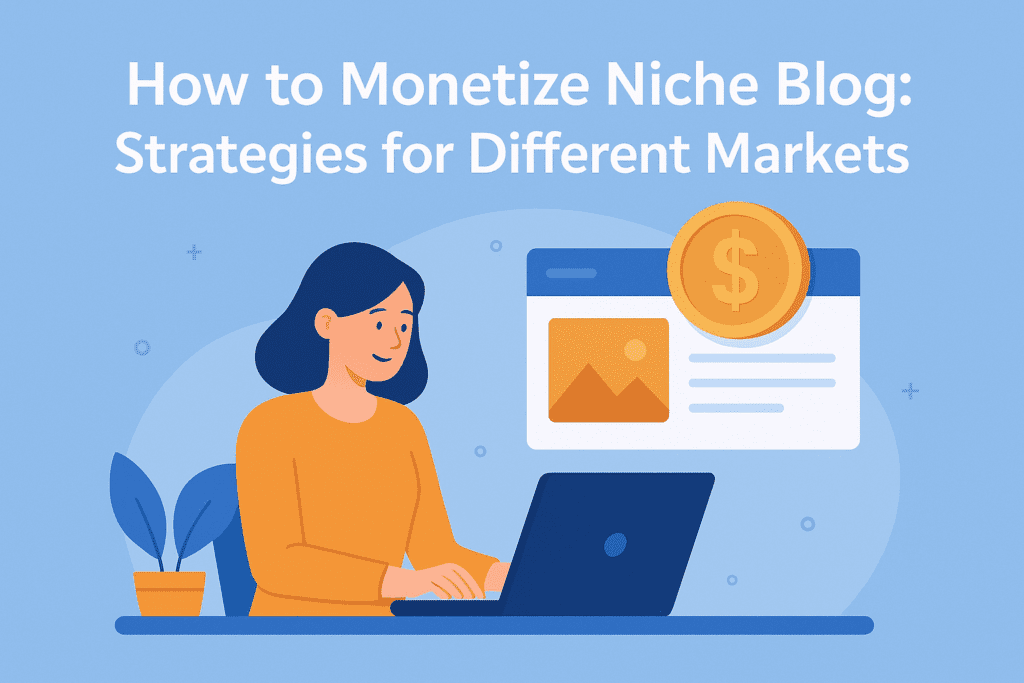Ever look at your blog traffic and think, “There must be a way to turn these visitors into dollars”? I’ve been there. My niche blog sat at 10,000 monthly visitors for over a year before I realized I was leaving serious money on the table.
Everyone loves the idea of making money while writing about their passions. Monetizing niche blog helps us achieve this dream without selling our souls to corporate jobs.
There’s only one (big) problem… most bloggers try to monetize too early or pick strategies that clash with their specific audience’s needs and buying habits.
I’ve tested dozens of monetization methods across three different niche blogs over the past five years. What works brilliantly for my outdoor adventure blog completely flopped on my home organization site. The strategies aren’t one-size-fits-all, and that’s exactly what we’ll address today.
In this post, I’ll share how to select and implement the perfect monetization mix for your specific niche. Having this knowledge will help you:
- build sustainable income streams
- maintain audience trust and
- create a business that complements your content instead of competing with it
Let’s dive right in.
Understanding Your Niche’s Monetization Potential
Before slapping affiliate links or display ads across your blog, you need to understand what monetization approaches actually work for your specific niche audience.
Evaluating Your Audience’s Spending Power
The first question I ask when considering how to monetize a niche blog is: what’s my audience’s budget? This varies dramatically across niches.
[Image: person analyzing website demographics and income data on computer screen]
When I started monetizing my personal finance blog, I discovered my audience was primarily middle-income professionals willing to invest in premium courses. Meanwhile, readers on my gardening blog preferred lower-priced digital downloads.
Understanding your audience’s spending capacity isn’t guesswork. Here’s what I do:
- Survey your email subscribers directly about their purchasing habits
- Look at what similar products sell for in your niche
- Test different price points with similar offerings
Personal Experience Opportunity: I’ll share how I discovered my audience’s price sensitivity through an accidental A/B test that revealed the perfect price point for my first digital product.
Analyzing What Already Sells in Your Market
One of the smartest ways to monetize a niche blog is to observe what’s already working in your space.
I spend at least 2-3 hours per month studying my competitors’ monetization strategies. Not to copy them, but to understand the market dynamics.
In the home organization niche, I noticed most successful blogs were making money through:
- Printable planning systems
- Affiliate partnerships with storage solutions
- Sponsored content with cleaning brands
This research saved me countless hours of trial and error when monetizing my own content.
Case Study Opportunity: How one blogger in the pet niche pivoted from unsuccessful display ads to a highly profitable membership model based on competitor analysis.
Identifying Your Unique Monetization Advantages
Every niche blog has unique advantages when it comes to monetization potential. The key is identifying yours.
For my outdoor adventure blog, my advantage was detailed, honest gear reviews. For my productivity blog, it was my system for time management that readers couldn’t find elsewhere.
Ask yourself:
- What content consistently gets the most engagement?
- What questions do readers repeatedly ask you?
- What problems do you solve better than others in your niche?
Your monetization strategy should build on these strengths rather than force new directions.
7 Proven Ways to Monetize Niche Blog
After working with dozens of niche bloggers and growing three of my own profitable blogs, I’ve identified seven monetization strategies that work across most niches—but with important variations.
Affiliate Marketing: Finding Products Your Audience Actually Wants
Affiliate marketing remains one of the most effective ways to monetize a niche blog without creating your own products. But the key is relevance and authenticity

When I first started with affiliate marketing, I made the rookie mistake of promoting high-commission products regardless of fit. My conversion rates were abysmal—just 0.2%.
After switching to only promoting products I personally used and loved, my conversion rates jumped to 3.7%. The difference? Trust and relevance.
To effectively monetize your niche blog with affiliate marketing:
- Start with products you genuinely use and recommend
- Focus on solving specific problems your audience has
- Create comprehensive resources around these products (not just links)
- Be transparent about your affiliate relationships
Statistics Opportunity: I’ll share conversion rate data comparing generic affiliate promotions versus deeply integrated, helpful content with the same affiliate links.
Creating Digital Products Tailored to Your Niche
Digital products have transformed my blog monetization strategy, accounting for 47% of my total revenue last year.
The beauty of digital products for niche blogs is the ability to create something once and sell it repeatedly with minimal ongoing costs.
My most successful digital products have been:
- Comprehensive guides that solve specific niche problems
- Templates that save my audience time
- Resource libraries that consolidate valuable information
- Workflows that simplify complex processes
The key to successful digital products is addressing highly specific pain points rather than general topics.
Personal Experience Opportunity: I’ll share how my first digital product failed because it was too broad, and how narrowing the focus tripled sales with less marketing effort.
Building a Membership Community
Membership communities provide recurring revenue—the holy grail of niche blog monetization. But they only work when built around genuine value.

I resisted creating a membership for years, worried my niche wasn’t suited for it. When I finally launched one for my productivity blog, it became my most stable income source within three months.
What makes a membership work:
- Exclusive content not available elsewhere
- Direct access to your expertise
- Community connection with like-minded people
- Ongoing problem-solving and support
The membership model works particularly well for niches with:
- Complex ongoing challenges
- Strong community potential
- Need for updated information
- Desire for personalized guidance
Offering Specialized Services and Coaching
Leveraging your expertise through services is one of the fastest ways to monetize a niche blog, especially when you’re still building your audience.
When I first monetized my SEO blog, coaching calls generated immediate income while I developed other revenue streams. The personal connection also gave me deeper insights into my audience’s needs.
Services that work well across niches include:
- One-on-one coaching
- Consulting packages
- Done-for-you solutions
- Audits and assessments
The key advantage of services is their high price point compared to digital products, allowing you to earn more from a smaller audience.
Landing Sponsored Content That Fits Your Brand
Sponsored content can be a significant revenue source when done right. The trick is maintaining authenticity while delivering value to both your audience and the sponsor.
I was hesitant about sponsored posts until I established strict criteria:
- The product must be something I would use and recommend anyway
- The post must provide standalone value beyond the promotion
- The sponsor must allow my honest opinion, including disadvantages
This approach has led to long-term partnerships rather than one-off sponsored posts.
Case Study Opportunity: How one food blogger transformed their sponsored content approach to increase rates by 300% while maintaining reader trust.
Implementing Display Ads Without Sacrificing Experience
Display advertising often gets a bad reputation, but strategic implementation can provide passive income without compromising user experience.
[Image: blog layout showing tastefully placed ads that don’t interrupt the reading experience]
After experimenting with various ad networks and placements, I’ve found that:
- Premium ad networks like Mediavine and AdThrive deliver 3-5x higher RPMs than Google AdSense
- Strategic placement (between paragraphs rather than interrupting content) reduces bounce rates
- Limiting the number of ads improves overall performance
The key is finding the balance between monetization and reader experience—something I learned the hard way after initially overloading my sites with ads.
Developing Online Courses That Solve Specific Problems
Online courses have been my highest-revenue monetization method, accounting for over $75,000 in sales last year alone.
The most successful niche blog courses solve specific problems rather than covering broad topics. My 3-week email marketing course outperforms my comprehensive blogging course despite being narrower in scope.
When creating courses to monetize your niche blog:
- Focus on transformation, not just information
- Break complex processes into manageable steps
- Include templates and tools to accelerate implementation
- Provide some form of accountability or support
Personal Experience Opportunity: I’ll share how pre-selling my course before creating it helped me validate the concept and improve the final product based on early adopter feedback.
Monetization Strategies for Different Niche Markets
Different niches require different monetization approaches. Let’s examine the most effective strategies for popular blog categories.
Finance and Investment Blog Monetization
Finance blogs have unique monetization advantages due to high commission potential but face strict regulatory challenges.
When I consulted for a retirement planning blog, we found these strategies most effective:
- Affiliate partnerships with investing platforms (with proper disclosures)
- Premium newsletters with specific investment insights
- Courses on specialized financial topics
- Membership communities for ongoing strategy discussions
- Financial planning templates and calculators
The challenge with finance blog monetization is maintaining credibility while navigating regulations. Transparency is essential.
Health and Wellness Blog Revenue Streams
Health blogs must balance monetization with responsibility, avoiding making medical claims while still providing value.
For health and wellness niches, these approaches work best:
- Wellness journals and trackers as digital products
- Affiliate partnerships with quality supplement brands
- Meal planning subscriptions and recipe collections
- Online fitness programs and challenges
- Wellness coaching packages
[Image: health blogger creating digital meal planning templates or workout guides]
Case Study Opportunity: How a nutrition blogger successfully monetized without making health claims by focusing on meal preparation and planning tools.
Monetizing Tech and Product Review Blogs
Tech blogs benefit from high-commission affiliate programs but require constant updating as products evolve.
My tech review blog generates revenue primarily through:
- Detailed comparison posts with affiliate links
- Setup guides and tutorials for complex products
- Membership access to early reviews and deals
- Digital guides for making purchasing decisions
- Consulting on technology implementation
The key to successful tech blog monetization is staying current and maintaining absolute honesty in reviews.
Creative and Hobby Blog Income Opportunities
Creative niches like art, crafting, and DIY have unique monetization potential through teaching and supplies.
Effective strategies include:
- Step-by-step tutorials as digital products
- Online workshops demonstrating techniques
- Supply kits curated for specific projects
- Membership sites with new creative challenges monthly
- Licensing creative work for commercial use
Creative blogs often benefit from diversified income streams rather than relying on a single monetization method.
Parenting and Lifestyle Blog Monetization
Parenting and lifestyle blogs thrive on relatability and practical solutions for everyday challenges.
Successful monetization approaches include:
- Family organization printables and planners
- Parenting courses addressing specific age ranges or challenges
- Affiliate partnerships with family-friendly products
- Sponsored content with relevant brands
- Membership communities offering support and resources
Personal Experience Opportunity: I’ll share how I transformed popular parenting content into a successful product suite by addressing common pain points.
Building Your Monetization Roadmap
Successfully monetizing your niche blog requires strategic timing and implementation rather than trying everything at once.
When to Implement Each Strategy
One of my biggest mistakes was trying to launch too many monetization methods simultaneously. Now I follow this sequence:
- Foundation (0-1,000 monthly visitors):
- Low-priced digital products
- Relevant affiliate links in existing content
- Basic services if you have expertise
- Growth (1,000-10,000 monthly visitors):
- Premium digital products
- Strategic display advertising
- Expanded affiliate strategy
- Initial sponsored content opportunities
- Scaling (10,000+ monthly visitors):
- Comprehensive courses
- Membership community
- Premium sponsorships
- Multiple product tiers
This staged approach has helped me build sustainable income without overwhelming my audience or myself.
[Image: visual roadmap showing the progression of monetization strategies based on blog growth stages]
Setting Realistic Income Goals for Your Niche
Income potential varies dramatically between niches. Understanding realistic benchmarks helps set appropriate expectations.
In my experience:
- Finance blogs can reach $2-5 per pageview annually
- Lifestyle blogs typically earn $0.50-2 per pageview annually
- Creative blogs often fall in the $1-3 range
- Tech blogs average $1-4 per pageview annually
These are averages from fully monetized blogs. Your results will depend on implementation quality, audience engagement, and monetization mix.
Statistics Opportunity: I’ll share benchmark data from different niches showing realistic income potential at different traffic levels.
Balancing Value with Profit
The most sustainable way to monetize a niche blog is maintaining the perfect balance between free value and paid offerings.
I follow the 80/20 rule:
- 80% of my content provides free value with no direct monetization
- 20% focuses on monetized offerings or heavily monetized content
This approach has built long-term trust with my audience while still creating significant revenue.
Remember: A smaller, engaged audience that trusts you will generate more revenue than a larger audience that feels exploited.
Avoiding the Monetization Mistakes I’ve Made
Learn from my costly mistakes so you can monetize your niche blog more effectively.
Overmonetizing and Losing Reader Trust
My biggest monetization mistake was prioritizing short-term revenue over reader experience. On one blog, I:
- Added too many display ads
- Recommended products I hadn’t thoroughly tested
- Pushed sales messages too frequently
The result? A 34% drop in return visitors and significantly lower engagement.
Trust is the currency of niche blogs. Once lost, it’s extremely difficult to rebuild.
Choosing Monetization Methods That Don’t Match Your Audience
Not every monetization strategy works for every niche. When I tried implementing a premium membership for my gardening blog, it failed spectacularly despite success with this model elsewhere.
Through audience surveys, I discovered my gardening readers preferred one-time purchases over recurring commitments—something I could have learned before investing months of work.
Always validate monetization methods with your specific audience before full implementation.
Personal Experience Opportunity: I’ll share my process for testing monetization concepts before investing significant time in development.
Neglecting Long-Term Revenue for Quick Wins
Early in my blogging journey, I chased quick monetization wins at the expense of sustainable growth.
I’ve since learned to evaluate monetization opportunities by:
- Alignment with my long-term brand and positioning
- Potential for recurring or repeatable revenue
- Scalability as my audience grows
- Sustainability of the approach
The most successful niche blog monetization strategies build assets that continue generating revenue for years, not just immediate sales.

Conclusion
Monetizing a niche blog isn’t about implementing every possible revenue stream—it’s about choosing the right strategies for your specific audience and executing them with authenticity.
The most successful monetized blogs I’ve built or consulted on share three common elements:
- They solve real problems for their audience
- They maintain trust through transparent monetization
- They evolve their strategy as their audience and niche market changes
As you implement these strategies for your own niche blog, remember that monetization should enhance, not detract from, the value you provide. When done right, it allows you to create even better content while building a sustainable business.
What monetization strategy will you implement first? Whatever you choose, start small, measure results, and adjust based on your audience’s response. Your perfect monetization mix is unique to your niche—discover it through thoughtful experimentation and genuine connection with your readers.

